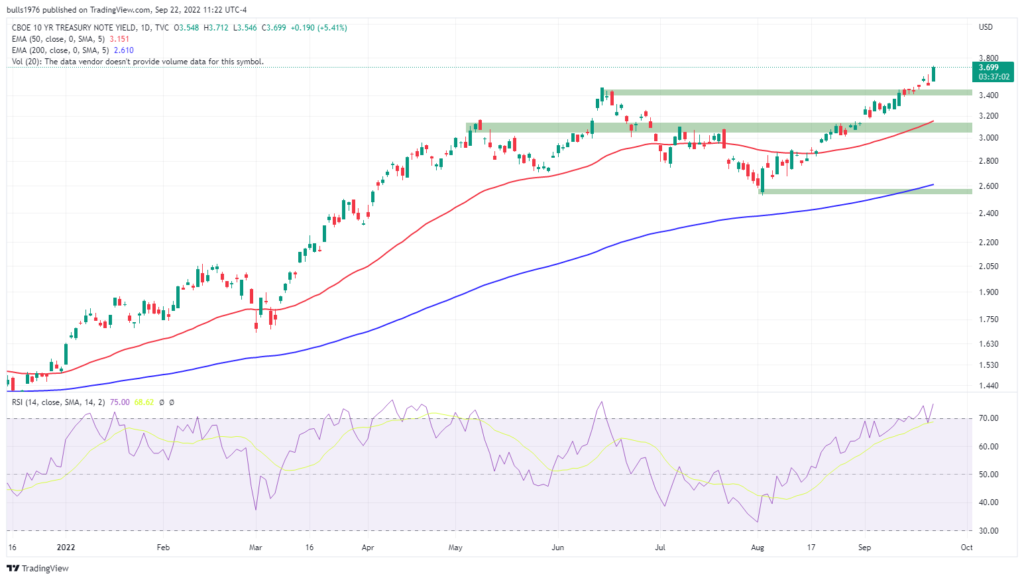Another Fed rate hike is in the books. You can read the full FOMC statement here.
Buy the dip
It’s widely known that (stocks) the S&P 500 index is in a bear market. Unfortunately, the “buy the dip” crowd didn’t get the memo as the VIX stubbornly stays below 30, screaming where not at the bottom yet!
Looking back, the last logical bear market for comparison purposes was 2001-2003. The bear market of 2007-2008 was epic and driven by crazy leverage making it harder to trade. This time around it feels more like 2001.
Regardless, it’s been a while and most “newer” traders have never experienced a bear market. As a result, these “newer” folks are locked into the “buy the dip” mindset, making it hard for stocks to bottom.
A valid reason why “buy the dip” is entrenched so deeply is because the Fed was always there to bail the market out with rate cuts the moment the boat started to wobble. Certainly, it’s taking a long time for them to abandon this money losing strategy.
Historically bear markets last about 2 years, and we’re only 9 months into this one.
Current Views
The market is trying to find and equilibrium in both interest rates and equity valuations.
My view is that a hawkish Fed is still being priced into the market, both rates and equities. As rates move higher, stocks move lower. It appears both bonds and stocks are overvalued.
Some perspective can help here. Back in 2001 US 10yr rates were about 5% and today 10yr rates are 3.7%. Overlaying inflation the situation becomes a head scratcher. CPI was 3.7% in 2001 (core 2.5%) and today it’s a red hot 8.2% (core 6.3%). So, we have wicked high inflation and rates way behind the curve.
Short-term stocks still look weak and look to test the June 14th S&P 500 low at 3600.
U.S. 10yr Note Yields

Trade update – short S&P 500
Disciplined traders follow strict risk management rules. Avoiding risk of ruin is job number one.
So, looking back my decision to cut risk just before yesterday’s Fed decision was a bad call. However, I find it beneficial to be flat when big news events happen. When I’m flat I’m free from bias. I can think clearly and assess the situation.
The SDS trade was profitable making 3% return over 5 trading days. Clearly, size mattered to make money on this trade. But it’s a winner regardless.
What now? I’m flat, unbiased and my view is still bearish.
Simple. Put the short trade back on with a tight stop loss. And that’s exactly what I’ve done.
The idea here is stay short into next week’s core PCE (inflation measure which the Fed references all the time) data release on Friday, September 30th.
I’m short the S&P 500 index via SDS (Proshares Ultrashort S&P 500 ETF) at $49.59 with a stop loss at 48.10 and a take profit at $52. Risking $600 to make $1000 over 5 days. Reassess on September 29th the day before core PCE.
Do I square up on Thursday or ride the wave?
Conclusion
Today’s wrap up is simple, stocks are in a bear market and your trades and positioning should reflect this view. That means underweight equities and overweight short duration gov’t bonds.
As rates move higher stocks move lower.
Equities as measured by the S&P 500 index are range bound with overhead resistance at 4300 and downside support at 3600. Trading this range appears to be a logical setup short-term.
Long-term passive investors care less about short-term fluctuations like what I’m describing here. They play the long game and don’t fork over a big chunk of their portfolio in fees. However, if you must invest capital immediately, dollar cost averaging into typical September seasonal weakness and US mid-term elections looks like a decent plan.
Thanks for reading!
Disclaimer: The content on this webpage is intended for informational and educational purposes only. No content on this webpage is intended as financial advice. The publisher of this website does not take any responsibility for possible financial consequences of any persons using the information in this educational content.
Invest at your own risk. Trade your own view. Do your own due diligence.
